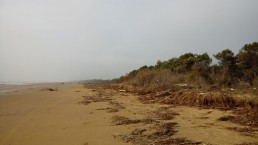Never before have we "RE-DUNIATED"
On 12 November 2019, an exceptional meteorological event caused extensive damage to the entire Veneto coastline. Municipalities and trade associations are once again asking for interventions and structural defence works to mitigate the damage caused by storm surges. We are no longer thinking only of rigid structures in the sea, or of beach nourishment, which have already shown all their limits.
Now they are calling for the introduction of a new effective and eco-sustainable element of protection: dunes..
For years the European and global scientific community has been demonstrating the extraordinary importance of dunes as a natural mitigation element of coastal risk, be it erosion or, as in this case, flooding. Beaches and dunes are very dynamic environments with a high resilience. They are the result of slow processes of sand accumulation by wind and plants, the real engineers of the dunes. Plants slow down the wind and trap the sand with their stems and roots, triggering the physical process of dune formation. It is precisely this dynamic balance between sand, wind and plants that makes the dunes the "sacrificial elements" of the coastal systems: in the event of strong sea storms, they are partially eroded, but in this way they dampen the force of the sea, protecting the hinterland, and give the sand back to the beach.
The first two years of experimentation, in various points along the Veneto coastline, have allowed the Life Redune team, and all the stakeholders closely following the project, to verify and confirm the aspects that condition the correct functioning of the dunes.
The first aspect is time. The time needed for the plants to grow and effectively exercise their function as builders and consolidators of the dunes. If we analyse the historical data on storm surges, we can observe a certain time cyclicity of the most important events, but the cycles are getting shorter. We have little time, we have to start now!
The second is proper planning. Not only of how and where to build new dunes or reinforce existing ones, but also of their maintenance over time.
The third aspect, perhaps the most important, is the need to launch a pathway to integrate environmental sustainability and the value of natural ecosystems into local spatial planning and development processes.
The best time to intervene is from autumn to spring, and the REDUNE team has never stopped putting all its skills and strengths into both the design and execution of interventions, in order to have new dunes for next summer. At the same time, the team continues to train and share its knowledge with the local authorities in charge of coastal design and management.



